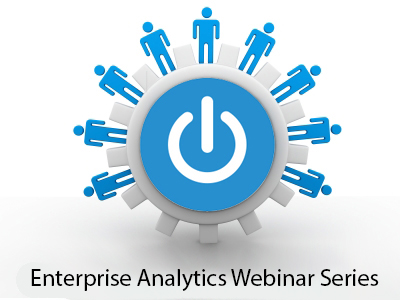Big data, data stitching, real-time reporting, conversion funnel optimization, the list goes on! Advanced digital analytics has led to amazing insights and helped businesses across the globe take their marketing efforts to new levels, with data backing the decision-making process. However, as with many successful marketing campaigns, proper planning and strategy need to be in place in order to hit goals and ultimately measure the effectiveness of any initiative. This is why a scalable, yet flexible analytics architecture is critical to the success of companies, particularly with enterprise-level data volumes, such as an online e-retailer.

In this post, I plan to discuss not only considerations to make when developing an enterprise analytics architecture for your organization but also why it’s so important for every organization to review their analytics set up.
Just Having Data Isn’t Good Enough Anymore
With any changes that need to happen on an enterprise level or across an entire organization, there will always be resistance, internally and externally. Some comments that may be deterents include “it costs too much”, “we don’t have enough resources or people”, “we already have analytics tools”, “it’ll take too much time to set up” and so on. These are all common speedbumps to rolling out an enterprise-level analytics solution. When we interact with customers that describe these pain points, we ask these few questions to help them better understand why just having data, or having data without a strong architecture, is a major problem:
- How much time does your team spend pulling actionable data?
- Do you know everything about your online visitors? How granular does your team go to understand visitor metrics and demographics?
- Can you accurately measure your digital spend ROI?
- What is the cost of executing marketing campaigns on bad data?
- Are you able to see the health of your organization across different verticals, teams, products and brands?
- Can you see attribution of your consumers as they make their way through the consumer journey to purchase/completing a goal?
- How confident are you in your data?
- Does everyone in your organization use data regularly for their marketing decisions and campaigns?
- Can you define the metrics you need for both short-term and long-term success?
Enterprise Analytics Architecture Best Practices
After understanding the right questions you and your organization need to think about and start investigating, it’s time to get down to business. After helping dozens of enterprise-level organizations set up their analytics architecture across hundreds of sites and digital properties globally, we have summarized the top best practices to consider:
1. Build goals for your data and understand your online key performance indicators. Any type of analytics set up you do is worthless without a clear vision of the end goal, even if its a moving target. Knowing what digital marketing campaigns drive the most revenue is a good start to determining all your goals for data.
2. Build a mapped out plan of everything you want to track, in detail, in order to make your company and organization more data-driven when making decisions. Part of setting up a measurement protocol is determining what measurement you need for your organization in order to make better marketing decisions and operate with a higher level of confidence in making truly informed decisions. Understanding what you want to track is just as important as ensuring it’s actually being tracked, and accurate.
3. Find, appoint or become an internal Data Evangelist and Champion. For enterprise-level analytics architecture to work, whether working with an analytics provider or analytics partner agency, having someone own the analytics deployment internally is critical to ensure the interests and needs of the organization can be expressed and measurement can be properly built, even if not built by this person/group of people. Becoming or finding a highly effective analyst internally in your organization does not have to be hard, as there is likely already someone in your organization that has this role or skillset! Michael Loban wrote a great blog post about how the value of analytics is only as good as the people using analytics.
4. Know your data limits and what you want to connect with your data. Most enterprise-level analytics tools, architecture, and strategies involve integration of multipe 3rd party data sets. This is particularly important when and/if you have hundreds or thousands of marketing campaigns running simultaneously. Having a strong grasp of all systems that can or should be integrated is needed to determine not only the best analytics solution, but also the best partner company to work with. Understanding data limits or volume can also help with determining budget needed to support enterprise-level analytics investment.
5. Remember, this is a long-term solution that will require training, support teams and innovators. Similar to finding your internal data evangelist, and equally important is thinking beyond initial implementation and set up. Considering long-term support needed to ensure data is always accurate will help your organization leverage data continuously for long-term data driven results. The web analytics industry is rapidly evolving, so having innovators on your team (internally or externally) is also necessary to make sure there are no missed opportunities with data and analytics’ capabilities.
6. Some specific enterprise-level analytics techniques to consider building your architecture is how roll-up reporting and cross-organizational data should be viewed, and by who. What this means is if your orgnaniztion has hundreds of brands, products, and teams, you will need to plan for multiple data views. This can be viewed in different segments, different user access permissions, and a way to not only collect data at a per-site granular level. However, on the flip side, you can also view your data at an enterprise-wide level by vertical, product category or by region of the world. Different analytics tools offer different methods to split traffic in certain ways, but only a few are designed to roll-up multiple web properties for this enterprise-wide data gathering. Another point of consideration is deployment of new tracking methods or custom segmentation across your site and how a tag management system may be the deployment solution as well. Andy Gibson wrote a great blog post on some of the easy applications you can utilize with Google Tag Manager and Google Analytics Premium.
Now what?
If you made it this far, you understand the value of enterprise-level analytics architecture and see the best practices but still may be wondering how to actually execute. As with almost anything in marketing, you need buy-in from the team and the decision makers first. Convincing your internal organization that data is vital to out-performing competition is easy when you can present all the missed opportunities and dollars lost for not having good analytics architecture and data reporting in place.
I encourage you to attend our upcoming webinars which will give you the information and confidence you need to prove the importance of well-defined enterprise analytics architecture, strategy and deployment.

Our upcoming webinars will cover (click to register for all webinars here):
- Is Your Google Analytics Data Accurate? – September 18 @ 1:00PM EST
Click here to sign up just for this free webinar. - Is Your Company Data Driven? Start now. – October 30, 1:00PM EST
Click here to sign up for just this free webinar. - Enterprise Analytics Architecture – December 4, 1:00 PM EST
Click here to sign up for just this free webinar. - Mastering Google Analytics Premium Features – December 11, 1:00 PM EST
Click here to sign up for just this free webinar.











